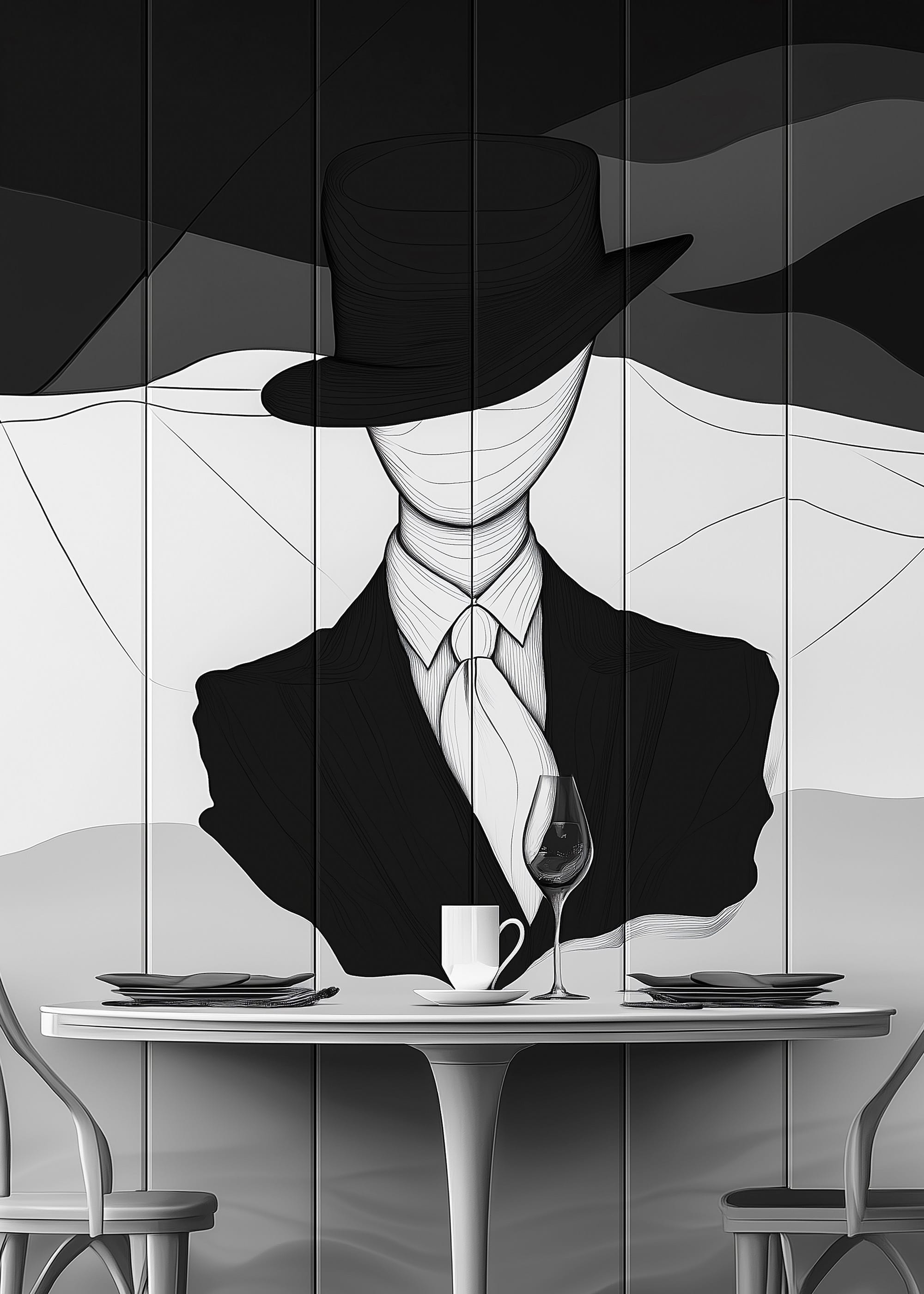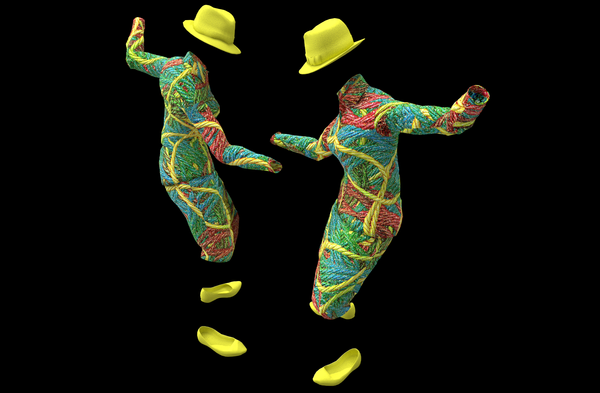In "The Invisible Diner," the artist offers viewers an enigmatic scene that evokes a sense of mystery, timelessness, and introspection. The figure, faceless yet refined, dressed in formal attire with a classic hat, appears at a table set for a quiet meal. The monochromatic color palette emphasizes the contrast between light and shadow, evoking a dreamlike atmosphere reminiscent of works by surrealist masters such as René Magritte. This artwork raises questions about identity, presence, and the relationship between the individual and their surroundings. This exploration will explore its thematic elements, symbolism, and potential interpretations.
The Theme of Identity and Anonymity
At the center of "The Invisible Diner" is a figure who lacks defining facial features. This anonymity hints at a loss or deliberate concealment of identity. Facelessness serves as a visual metaphor for how people can be rendered invisible by society—whether through the pressures of conformity, anonymity within the masses, or even self-imposed isolation. The absence of a face also invites the viewer to project themselves into the artwork, establishing a personal connection with the subject.
The concept of anonymity is further emphasized using the classic suit and bowler hat. These elements evoke an era when such attire was synonymous with conformity and status. The figure’s lack of individual features, contrasted with the distinct formal clothing, raises questions about how society defines identity—is it through outward appearances, or is it something more intrinsic? The artwork seems to suggest that, in many ways, the identity of the modern individual is constructed and defined externally, sometimes at the cost of losing one's sense of self.
The Setting and Its Implications
The setting—a simple table adorned with a white cup, a wine glass, and a modest place setting—suggests a solitary dining experience. The lack of other visible diners implies isolation. With its stark lines and fluid shapes, the minimalistic background conveys a sense of detachment from reality. It feels as though this diner exists outside the typical passage of time, floating in an in-between space that could either be a dream or a manifestation of the inner mindscape of the invisible figure.
The juxtaposition of the refined dining elements with the faceless figure underscores the tension between outward appearances and inner reality. Though the scene is set for an elegant dining experience, the arrangement is empty—a sense of absence that mere material comforts cannot fill. The sparse setting can be interpreted as a critique of the superficiality of modern life, where an emphasis on the material and external presentation sometimes overshadows actual substance and meaning.
The Influence of Surrealism
"The Invisible Diner" borrows heavily from surrealist influences, echoing the works of artists like René Magritte and Salvador Dalí. The faceless figure calls to mind Magritte’s series of faceless men in bowler hats, where identity is obscured or transformed into something that defies conventional logic. Magritte's work often explored mystery themes, the ordinary juxtaposed with the bizarre, and the tension between visibility and concealment. Similarly, this piece invites viewers to confront the familiar—a dining set, a suited figure—in a disquietingly strange way.
The monochromatic color scheme reinforces the surreal quality of the work. By stripping away the distractions of color, the artist forces the viewer to focus on the form, composition, and symbolism present in the piece. The stark interplay between black and white adds a layer of visual drama, heightening the sense of otherworldliness and suggesting a duality—perhaps between the known and the unknown, reality and illusion, or presence and absence.
The use of surrealism in "The Invisible Diner" probes deeper psychological truths, presenting a visual puzzle that resists straightforward interpretation. The faceless figure, the empty setting, and the unreal environment all seek to tap into the subconscious mind, leaving viewers with more questions than answers.

Symbolism and Interpretation
The symbolism in "The Invisible Diner" is rich and multi-layered. The facelessness of the figure is perhaps the most potent symbol, representing the loss of individuality in a world that often prioritizes conformity. The hat and suit, traditional markers of social status, become symbols of anonymity rather than distinction, suggesting that outward symbols of success can mask a person's true essence.
The dining table itself carries symbolic weight. Typically, it is a social gathering place, but it becomes an instrument of isolation here. The solitary cup and wine glass symbolize communion and indulgence but feel empty and devoid of their usual warmth. This emptiness can be interpreted as a critique of the superficial nature of modern social rituals—we gather and consume but often do not connect on a deeper level.
Additionally, the artwork's stark, dreamlike composition evokes feelings of disconnection and solitude. The abstract background, with its flowing lines and ambiguous shapes, suggests a shifting and unstable reality. This sense of fluidity can be seen as a reflection of the instability of identity in an ever-changing world. The lack of a defined setting—indoors or outdoors—suggests that the figure is in a liminal space between worlds, much like how individuals sometimes feel disconnected from their internal and external environments.
Emotional Response
The emotional response "The Invisible Diner" elicits is complex and multifaceted. At first glance, there is a sense of unease—the faceless figure, the stark black-and-white palette, and the emptiness of the setting all contribute to an atmosphere that feels somewhat unsettling. Yet, there is also a sense of calmness and introspection. The composition's simplicity, the lines' elegance, and the scene's minimalism create a contemplative mood rather than chaos.
Viewers may find themselves reflecting on their own experiences of anonymity and isolation. The artwork speaks to the universal human experience of sometimes feeling invisible—whether in a crowd, within societal structures, or even within oneself. The faceless diner becomes a mirror, allowing viewers to confront their emotions regarding identity, presence, and the desire for connection.

The Invisible Diner © Nicholas V. K.
A faceless figure in a suit sits at a table, blending mystery and surrealism in a black-and-white dreamscape.
The Broader Context
"The Invisible Diner" can also be interpreted within the broader context of contemporary society. In an age defined by social media and hyper-connectivity, the concept of invisibility takes on new meanings. While we are constantly visible online, curating our identities for others to see, there is often a disconnect between this projected persona and our true selves. The faceless figure in "The Invisible Diner" can be seen as a commentary on this paradox—how we can simultaneously be hyper-visible and profoundly invisible.
The artwork may also be interpreted as a critique of consumer culture. The dining setting, typically associated with luxury, comfort, and social interaction, is here reduced to an empty ritual. The solitary figure, surrounded by the trappings of a fine meal but devoid of any real engagement, reflects the emptiness accompanying the pursuit of material wealth and social status without deeper meaning or connection.
Artistic Techniques
From a technical perspective, "The Invisible Diner" demonstrates a masterful use of line, contrast, and composition. The artist's decision to use a monochromatic palette effectively conveys the themes of isolation and anonymity. The lack of color strips away any sense of warmth or familiarity, leaving only the stark outlines of the figure and setting. This use of black and white emphasizes the duality in the piece—between presence and absence, visibility and invisibility.
The lines in the artwork are fluid yet precise, creating a sense of movement that contrasts with the stillness of the figure. This interplay between movement and stillness adds to the surreal quality of the piece, suggesting that while the figure may be physically present, they are mentally or emotionally elsewhere. Negative space is also notable, with the empty areas around the figure contributing to the overall sense of isolation and detachment.
In Summation
"The Invisible Diner" is a powerful exploration of themes related to identity, anonymity, and the human condition. The artwork invites viewers to reflect on their experiences of presence and absence, connection and isolation through surreal imagery, stark contrasts, and symbolic elements. The faceless figure, dressed in the trappings of social status but devoid of any defining features, serves as a poignant reminder of how modern life can strip away individuality, leaving only an empty shell behind.
The artwork's evocative imagery and layered symbolism make it a compelling piece that resonates emotionally and intellectually. It challenges viewers to look beyond the surface to question the nature of identity and how we interact with the world around us. In a society that often prioritizes outward appearances and superficial connections, "The Invisible Diner" is a powerful reminder of the importance of looking inward, finding meaning beyond the material, and seeking genuine connection in an increasingly disconnected world.






